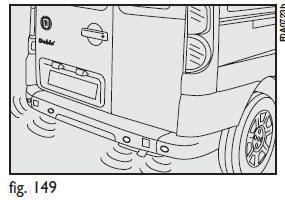Parking sensors are located in the rear bumper to detect and inform the driver (through an intermittent acoustic signal) about the presence of obstacles behind the vehicle.
ACTIVATION
Sensors will activate automatically when engaging reverse gear.
The frequency of the acoustic alarm will increase as the distance between the vehicle and the obstacle decreases.
BUZZER WARNINGS
When the reverse gear is engaged an intermittent acoustic signal is automatically activated (short beep to signal system activation).
The acoustic signal frequency:
Ц becomes louder as the reduction of distance between the vehicle and the obstacle decreases;
Ц becomes continuous when the distance between the vehicle and the obstacle is less that 30 cm and stops immediately if the distance raises;
Ц is constant if the distance is unvaried.
IMPORTANT
In the event of a parking sensor system failure, you will hear an alarm signal when you engage reverse gear.
The sensors are shaped to fit into the bumpers and optimise scanning angles.

Detection distances:
Central ray ................................130 cm
Corner action range ................ 60 cm
Min/max range ................... 25/180 cm
If several sensors signal an obstacle, the control unit checks and indicates the closest one.
The system will automatically cut out also when reverse gear is engaged after a distance of 50 or after exceeding the speed of 30 km/h.

For proper operation, the parking sensors shall always be clean from mud, dirt, snow or ice. Therefore keep the rear bumpers clean to prevent irregular operation of the parking sensors.
See also:
Clock mode (Clock Mode)
This function is used to set the clock in the 12h (12 hour) or 24h (24 hour)
mode. To adjust proceed as follows:
...
Normal Starting
NOTE: Normal starting of either a cold or a warm engine is obtained without pumping
or pressing the accelerator pedal.
Turn the ignition switch to theAVV (START) position and release it when the e ...
Pollen filter
The pollen filter is located under the dashboard near the central dashboard unit
on passenger side.
REPLACING THE FILTER
Loosen the screws (A) and remove the filtering element to be replaced. ...


